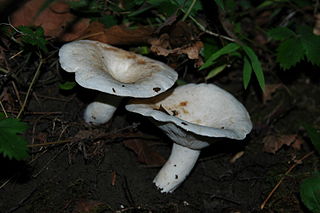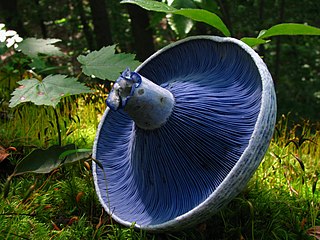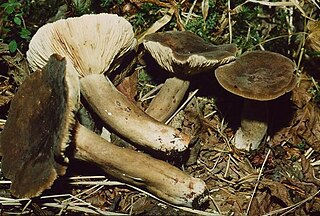
The Russulaceae are a diverse family of fungi in the order Russulales, with roughly 1,900 known species and a worldwide distribution. They comprise the brittlegills and the milk-caps, well-known mushroom-forming fungi that include some edible species. These gilled mushrooms are characterised by the brittle flesh of their fruitbodies.

Lactarius is a genus of mushroom-producing, ectomycorrhizal fungi, containing several edible species. The species of the genus, commonly known as milk-caps, are characterized by the milky fluid ("latex") they exude when cut or damaged. Like the closely related genus Russula, their flesh has a distinctive brittle consistency. It is a large genus with over 500 known species, mainly distributed in the Northern hemisphere. Recently, the genus Lactifluus has been separated from Lactarius based on molecular phylogenetic evidence.

Lactarius deterrimus, also known as false saffron milkcap or orange milkcap, is a species of fungus in the family Russulaceae. The fungus produces medium-sized fruit bodies (mushrooms) with orangish caps up to 12 centimetres wide that develop green spots in old age or if injured. Its orange-coloured latex stains maroon within 30 minutes. Lactarius deterrimus is a mycorrhizal fungus that associates with Norway spruce and bearberry. The species is distributed in Europe, but has also found in parts of Asia. A visually similar species in the United States and Mexico is not closely related to the European species. Fruit bodies appear between late June and November, usually in spruce forests. Although the fungus is edible—like all Lactarius mushrooms from the section Deliciosi—its taste is often bitter, and it is not highly valued. The fruit bodies are used as source of food for the larvae of several insect species. Lactarius deterrimus can be distinguished from similar Lactarius species by difference in the mycorrhizal host or latex colour.

Lactarius torminosus, commonly known as the woolly milkcap or the bearded milkcap, is a large species of agaric fungus. A common and widely distributed species, it is found in North Africa, northern Asia, Europe, and North America. It was first described scientifically by Jacob Christian Schäffer in 1774 as an Agaricus, and later transferred to the genus Lactarius in 1821 by Samuel Frederick Gray. A variety, L. torminosus var. nordmanensis, is known from the United States, Canada, and Switzerland. L. torminosus officially became the type species of Lactarius in 2011 after molecular studies prompted the taxonomic reshuffling of species between several Russulaceae genera.

Milk-cap is a common name that refers to mushroom-forming fungi of the genera Lactarius, Lactifluus, and Multifurca, all in the family Russulaceae. The common and eponymous feature of their fruitbodies is the latex ("milk") they exude when cut or bruised. Mushrooms with typical milk-cap characteristics are said to have a lactarioid habit. Some of them are edible.

Lactifluus piperatus, commonly known as the blancaccio, is a semi-edible basidiomycete fungus of the genus Lactifluus. Despite being edible, it is not recommended by some because of its poor taste, though can be used as seasoning when dried. The fruiting body is a creamy-white mushroom which is funnel-shaped when mature, with exceptionally crowded gills. It bleeds a whitish peppery-tasting milk when cut. Widely distributed across Europe and eastern North America, Lactifluus piperatus has been accidentally introduced to Australia. Mycorrhizal, it forms a symbiotic relationship with various species of deciduous tree, including beech, and hazel, and fruiting bodies are found on the forest floor in deciduous woodland.

Lactarius vietus is a species of fungus in the family Russulaceae, first described by Elias Magnus Fries. It produces moderately sized and brittle mushrooms, which grow on the forest floor or on rotting wood. The flattened-convex cap can vary in shape, sometimes forming the shape of a wide funnel. It is typically grey, but the colour varies. The species has crowded, light-coloured gills, which produce white milk. The spore print is typically whitish, but also varies considerably. The mushrooms typically have a strong, acrid taste and have been described as inedible, but other authors have described them as consumable after boiling. L. vietus feeds by forming an ectomycorrhizal relationship with surrounding trees, and it favours birch. It grows in autumn months and is fairly common in Europe, North America and eastern Asia.

Lactarius indigo, commonly known as the indigo milk cap, indigo milky, the indigo lactarius, or the blue milk mushroom, is a species of agaric fungus in the family Russulaceae. It is a widely distributed species, growing naturally in eastern North America, East Asia, and Central America; it has also been reported in southern France. L. indigo grows on the ground in both deciduous and coniferous forests, where it forms mycorrhizal associations with a broad range of trees. The fruit body color ranges from dark blue in fresh specimens to pale blue-gray in older ones. The milk, or latex, that oozes when the mushroom tissue is cut or broken — a feature common to all members of the genus Lactarius — is also indigo blue, but slowly turns green upon exposure to air. The cap has a diameter of 5–15 cm (2–6 in), and the stem is 2–8 cm (0.8–3 in) tall and 1–2.5 cm (0.4–1.0 in) thick. It is an edible mushroom, and is sold in rural markets in China, Guatemala, and Mexico. In Honduras, the mushroom is called a chora, and is generally eaten with egg; generally as a side dish for a bigger meal.

Lactarius sanguifluus, commonly known as the bloody milk cap, is a species of fungus in the family Russulaceae. First described from France in 1811, the species was given its current name by Elias Fries in 1838 when he transferred it to Lactarius. Found in Asia, Mediterranean Africa, and Europe, fruit bodies (mushrooms) grow scattered or in groups on the ground under conifers, especially Douglas fir. When bruised or cut, the fruit bodies ooze a blood-red to purple latex that slowly turns greenish upon exposure to air. The caps are orangish to reddish-brown, and become funnel-shaped with age. The gills are pinkish to purplish. Different forms have been described from Italy, but these are not universally accepted as distinct. L. sanguifluus mushrooms are edible, and sold in rural markets of Europe and Asia. Fruit bodies grown in polluted soil, including roadsides subject to heavy traffic, can bioaccumulate toxic heavy metals. Several sterols and pigment have been isolated and identified from the mushrooms.

Lactarius alnicola, commonly known as the golden milkcap, is a species of fungus in the family Russulaceae. The fruit bodies produced by the fungus are characterized by a sticky, vanilla-colored cap up to 20 cm (7.9 in) wide with a mixture of yellow tones arranged in faint concentric bands. The stem is up to 5 cm (2.0 in) long and has yellow-brown spots. When it is cut or injured, the mushroom oozes a white latex, which has an intensely peppery taste. The acrid taste of the fruit bodies renders them unpalatable. The fungus is found in the western United States and Mexico, where it grows in mycorrhizal associations with various coniferous trees species, such as spruce, pine and fir, and deciduous species such as oak and alder. It has also been collected in India. Two varieties have been named: var. pitkinensis, known from Colorado, and var. pungens, from Michigan.

Lactarius pubescens, commonly known as the downy milk cap, is a species of fungus in the family Russulaceae. It is a medium to large agaric with a creamy-buff, hairy cap, whitish gills and short stout stem. The fungus has a cosmopolitan distribution, and grows solitarily or in scattered groups on sandy soil under or near birch.

Lactarius fallax, commonly known as the velvety milk cap, is a species of fungus in the family Russulaceae. Found in both spruce and mixed conifer forests, it is a fairly common species in the Pacific Northwest region of North America, with a northerly range extending to Alaska. Its fruit bodies are medium-sized, with velvety, brown to blackish caps up to 3–9 cm (1.2–3.5 in) in diameter bearing a distinct pointed umbo. The caps are supported by velvety stems up to 6 cm (2.4 in) long and 1.5 cm (0.6 in) thick. The mushroom oozes a whitish latex when it is cut, and injured tissue eventually turns a dull reddish color. The eastern North American and European species Lactarius lignyotus is closely similar in appearance, but can be distinguished by its differing range.

Lactifluus deceptivus, commonly known as the deceiving milkcap, is a common species of fungus in the family Russulaceae. It is found throughout eastern North America on the ground in coniferous forests near hemlock or deciduous forests near oak, and in oak-dominated forests of Costa Rica. It produces large mushrooms with funnel-shaped caps reaching up to 25 cm (9.8 in) in diameter, on top of hard white stems that may reach 4–10 cm (1.6–3.9 in) long and up to 3 cm (1.2 in) thick. The gills are closely spaced together and yellowish-cream in color. When young, the cap is white in all parts, but the depressed center becomes dull brownish in age and breaks up into scales. The edge of the cap has a roll of cottony tissue that collapses as the cap expands. The surface of the stem—especially near the base—has a velvety texture. The mushroom "bleeds" a milky white acrid latex when it is cut or injured. Similar milk-cap species with which L. deceptivus might be confused include Lactifluus piperatus, L. pseudodeceptivus, L. caeruleitinctus, L. subvellereus, Lactarius arcuatus and Lactarius parvulus.

Lactarius argillaceifolius is a species of fungus in the family Russulaceae. The mushrooms produced by the fungus have convex to flattened drab lilac-colored caps that are up to 18 cm (7.1 in) wide. The cream-colored gills are closely spaced together and extend slightly down the length of the stem, which is up to 9 cm (3.5 in) long by 3.5 cm (1.4 in) thick. The mushroom produces an off-white latex when injured that stains the mushroom tissue brownish.

Lactarius vinaceorufescens, commonly known as the yellow-staining milkcap or the yellow-latex milky, is a poisonous species of fungus in the family Russulaceae. It produces mushrooms with pinkish-cinnamon caps up to 12 cm (4.7 in) wide held by pinkish-white stems up to 7 cm (2.8 in) long. The closely spaced whitish to pinkish buff gills develop wine-red spots in age. When it is cut or injured, the mushroom oozes a white latex that rapidly turns bright sulfur-yellow. The species, common and widely distributed in North America, grows in the ground in association with conifer trees. There are several other Lactarius species that bear resemblance to L. vinaceorufescens, but most can be distinguished by differences in staining reactions, macroscopic characteristics, or habitat.

Lactifluus corrugis, commonly known as the corrugated-cap milky, is an edible species of fungus in the family Russulaceae. It was first described by American mycologist Charles Horton Peck in 1880.

Lactarius fuliginosus, commonly known as the sooty milkcap, is a species of fungus in the family Russulaceae. The medium-sized fruit bodies have velvety, grayish-brown caps and crowded gills. It is found in deciduous forests of Asia, Europe, and North America.

Lactarius porninsis, the larch milkcap, is a member of the large milk-cap genus Lactarius in the order Russulales. It is found in Europe and Asia, where it grows in a mycorrhizal association with larch.

Lactifluus is one of three genera of mushroom-forming fungi containing species commonly named "milk-caps", the others being Lactarius and Multifurca. It has been separated from Lactarius based on molecular phylogenetic evidence but is very similar to that genus. There are roughly 150 known Lactifluus species, which have a mainly tropical distribution but are also found in the north temperate zone and Australasia. Some of them are edible mushrooms.

Lactifluus clarkeae, formerly known as Lactarius clarkeae, is a species of mushroom-forming fungus in the family Russulaceae. It is found in Australia and New Zealand in mycorrhizal association with species of Nothofagus and the family Myrtaceae.


























